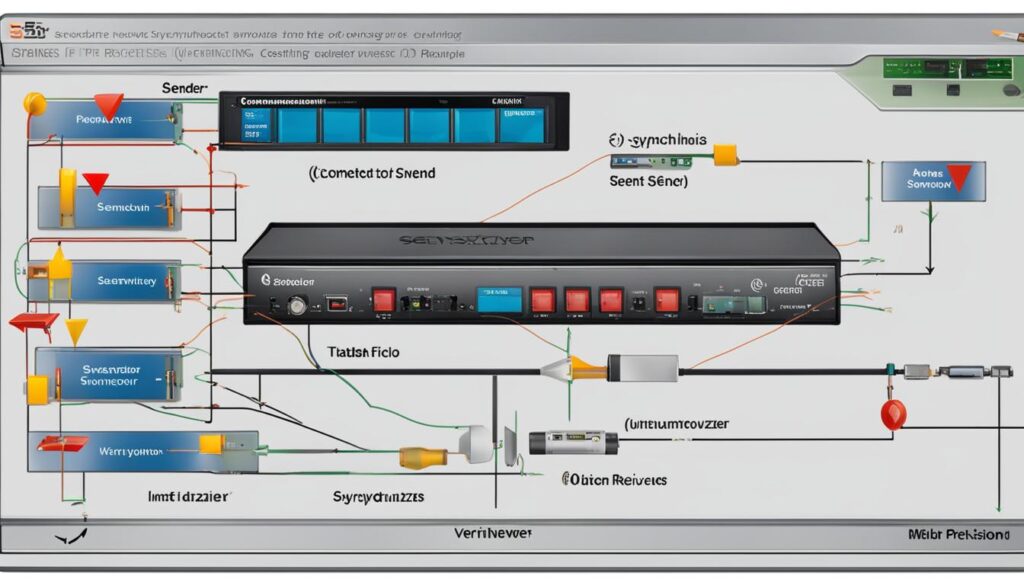Handshake protocols are crucial in maintaining hygiene and health safety during personal interactions. At our company, we understand the significance of effective CDC (clock domain crossing) techniques in ensuring the correct transfer of signals between clock domains. In this article, we will explore the intricacies of handshake protocols and how they contribute to robust design and verification processes.
When it comes to CDC techniques, handshake protocols involve a request-acknowledge process that ensures reliable data transmission. It begins with a request being sent from the source domain, triggering the waiting process in the destination domain. This allows for precise data capture and synchronization between clock domains.
However, traditional CDC tools may encounter challenges in accurately recognizing and verifying handshake-based synchronizers, leading to false violations. Our company has developed advanced CDC techniques using static analysis methodologies to overcome these challenges effectively.
In the following sections, we will delve deeper into the challenges associated with handshake synchronizers and explore verification strategies for both handshake synchronizers and FIFO synchronizers. We will also discuss multi-bit CDC strategies, naming conventions, and design partitioning techniques that enhance the efficiency of clock domain crossing design.
Throughout this article, we aim to provide insights and solutions that enable designers to optimize their CDC techniques, mitigate risks, and ensure the robustness of their systems. Let’s embark on this journey to enhance our understanding of CDC techniques and their critical role in clock domain crossings.
Table of Contents
Challenges with FIFO and Handshake-Based Synchronization
Clock domain crossings involving FIFO synchronizers, handshake synchronizers, and other synchronization mechanisms present unique challenges in the verification process. These structures are commonly found in large design modules and are critical for ensuring correct data transfer between different clock domains. However, detecting and functionally verifying these crossings can be difficult.
Traditional clock domain crossing (CDC) tools often struggle to accurately recognize properly synchronized crossings, leading to false violations. This can result in wasted time and effort spent manually filtering out these false violations and can also lead to the risk of missing actual violations.
To overcome these challenges, new CDC tools have been developed that utilize advanced static analysis techniques. These tools combine functional and structural analysis to accurately identify and verify FIFO and handshake synchronizers, as well as other clock domain crossings. By adopting these tools, designers can reduce the risk of false violations and improve the efficiency of the verification process.
FIFO Synchronizers and Handshake Synchronizers
FIFO synchronizers and handshake synchronizers are two common types of synchronization mechanisms used in clock domain crossings.
FIFO synchronizers are utilized for transferring data between clock domains with different or variable rates. These structures involve a First-In-First-Out (FIFO) buffer that stores data generated by a source until it can be safely transferred to the destination domain. Asynchronous FIFOs and synchronous FIFOs are commonly used in different scenarios, requiring specific verification techniques for each type.
Handshake synchronizers are another type of synchronization mechanism used in clock domain crossings. These structures rely on request-acknowledge protocols, where a request signal is sent from the source domain to the destination domain, signaling the availability of data. The destination domain waits for the request signal before capturing the data, ensuring proper synchronization.
Verifying the correct functionality of these synchronizers is crucial to prevent data loss, ensure reliable transfer, and avoid timing issues and metastability problems across different clock domains.
Verifying Handshake Synchronizers
When it comes to verifying handshake synchronizers, we need to focus on recognizing and verifying various components that play a crucial role in ensuring a secure and reliable data transfer. Let’s take a closer look at the key elements that need to be verified for handshake synchronizers.
Recognizing and Verifying Data Transfer
One of the essential aspects of verifying handshake synchronizers is ensuring the proper recognition and verification of the data transfer process. This involves examining the correct enable detection mechanism through elements such as muxes or flops. By thoroughly analyzing the enable detection logic, we can ensure that the data transfer occurs correctly between the source and destination domains.
Source and Destination Controller Identification
Another critical step in verifying handshake synchronizers is identifying the source and destination controllers accurately. This helps us understand the ownership and responsibility of each domain in the handshake process. By verifying the correct operation and timing of these controllers, we can ensure the overall integrity of the handshake mechanism.
Request and Acknowledge Behavior
The behavior of request and acknowledge signals is a crucial aspect of handshake synchronizers. These signals establish the communication protocol between the source and destination domains. Verifying the expected behavior of request and acknowledge signals ensures that the handshake process is correctly initiated, acknowledged, and completed without any discrepancies.
Data Capture Window Check
During the handshake process, it is vital to verify the data capture window to ensure the accurate capture of transferred data in the destination domain. By performing a thorough data capture window check, we can confirm that the captured data is valid, error-free, and within the expected window to maintain data integrity.
For the verification of handshake synchronizers, static verification techniques provide an ideal approach. Static analysis helps us perform exhaustive checks and ensure the correctness of the handshake scheme at various levels of abstraction, significantly reducing the risk of errors.
Overall, by meticulously verifying and validating the different components such as data transfer, source, and destination controller identification, request and acknowledge behavior, and data capture window, we can ensure the reliable functioning of handshake synchronizers. This attention to detail and comprehensive verification process allows us to design robust systems that seamlessly transfer data between clock domains.
Verifying FIFO Synchronizers
FIFOs are extensively used to transfer data between a source and a destination operating at different or variable rates. However, these data transfer structures often involve multiple clock domain crossings, posing challenges during the verification process.
When it comes to asynchronous FIFOs, verifying the empty- and full-flag calculation as well as the data read to the destination domain requires careful attention. Traditional tools commonly fail to recognize FIFO synchronizers, which, in turn, compels designers to manually filter false violations.
To address this issue, CDC verification techniques for FIFO synchronizers have been developed. These techniques offer automatic detection and efficient verification for overflow and underflow conditions. By leveraging these advancements, designers can streamline the verification process, ensuring the correctness and reliability of their designs.
The Challenge with FIFOs
Asynchronous FIFOs are widely used in modern electronic systems to enable data transfer between clock domains with variable data rates. This poses a challenge in terms of ensuring the proper functioning of these FIFOs across different clock domains. Traditional verification methodologies often fail to accurately detect and verify these FIFO synchronizers, leading to false violations and potentially compromising the integrity of the system.
New Approaches to FIFO Verification
To address the challenges associated with FIFO verification, new CDC verification techniques have been developed. These techniques focus on automatically detecting and verifying various aspects of FIFO synchronizers, including overflow and underflow conditions. By leveraging these techniques, designers can ensure the proper functioning and reliability of their FIFO-based designs.
An important aspect of FIFO verification is the detection of empty- and full-flag calculation. This involves accurately verifying when the FIFO is empty or full, enabling efficient data transfer between clock domains. Additionally, the verification of data read to the destination domain is crucial to ensure the integrity and consistency of the transferred data.
The Benefits of Efficient FIFO Verification
Efficient verification of FIFO synchronizers offers numerous benefits for designers. By automating the detection and verification process, designers can save time and effort, allowing them to focus on other critical aspects of their designs. Additionally, efficient FIFO verification reduces the risk of false violations, ensuring the correctness and reliability of the system.
Overall, the development of CDC verification techniques specifically targeted at FIFO synchronizers has significantly improved the verification process for designs involving asynchronous FIFOs. These advancements bring greater confidence and efficiency to designers, enabling them to create robust and reliable systems.

We’re continuously working towards optimizing the verification process for FIFOs.
Strategies for Passing Multiple Signals between Clock Domains
When it comes to passing multiple signals between clock domains, careful design and verification techniques are essential. To ensure the correct transfer of multiple signals, we can employ multi-bit CDC strategies, such as signal consolidation.
Signal consolidation involves combining multiple signals into a single control signal, simplifying the CDC process. This strategy not only reduces the complexity of handling multiple signal crossings but also improves the overall efficiency of the design.
To effectively consolidate multiple signals, designers can utilize multi-cycle paths and synchronizing counters. Multi-cycle paths allow for the proper timing and sequencing of signals across clock domains, ensuring accurate data transfer. Synchronizing counters help address the challenges of passing multiple CDC signals by providing synchronization points between clock domains.
Benefits of Multi-bit CDC Strategies:
- Reduced complexity in handling multiple signal crossings
- Improved efficiency and resource utilization
- Enhanced data transfer accuracy and reliability
- Effective synchronization between clock domains
By implementing these strategies, designers can overcome the complexities associated with passing multiple signals between clock domains. The use of multi-bit CDC techniques, such as signal consolidation, enables smoother and more efficient data transfer, ensuring the integrity of the system’s functionality.
Example Multi-bit Signal Consolidation:
| Signal A | Signal B | Signal C | Consolidated Signal |
|---|---|---|---|
| 1 | 0 | 1 | 1 |
| 0 | 1 | 0 | 0 |
| 1 | 1 | 0 | 1 |

In the example above, Signal A, Signal B, and Signal C are consolidated into a single control signal. This consolidation simplifies the CDC process, reducing the number of crossings and improving efficiency.
Naming Conventions and Design Partitioning
When it comes to efficient and organized clock domain crossing design, naming conventions and design partitioning play a crucial role in ensuring seamless integration and timing verification. By following clear and consistent clock and signal naming conventions, we can enhance our understanding of the design and facilitate accurate timing analysis.
Properly naming clocks and signals not only improves the readability and maintainability of the design but also aids in identifying any potential timing violations. When reviewing the design, descriptive and meaningful names enable us to quickly recognize the purpose and functionality of each signal.
Consistent naming conventions also help prevent confusion in large and complex designs, making it easier for designers and verification engineers to collaborate effectively. By adhering to standardized naming conventions, we promote a streamlined development process and reduce the chances of misinterpretation, errors, and inefficiencies.
Additionally, design partitioning is essential for managing complex clock domain crossings. Breaking down the design into smaller, manageable modules allows us to focus on specific tasks, reduce complexity, and prioritize the timing analysis of individual clock-partitioned modules. This targeted approach enables us to detect and address potential timing issues more effectively, ensuring the overall design functions as intended.
Benefits of Design Partitioning
Design partitioning provides several benefits:
- Modular approach: Partitioning the design into smaller modules allows for easier testing, verification, and debugging. Each module can be independently tested, leading to better isolation of issues and more efficient design optimization.
- Improved performance: By dividing a large design into smaller components, we can identify specific areas that may require performance improvements. Targeting these areas individually enables us to optimize the overall design for better performance.
- Easy integration: Design partitioning simplifies the integration of various modules, as each module can be independently developed and verified. This modular approach facilitates efficient integration and reduces the risk of errors during the integration process.
- Enhanced collaboration: Breaking down the design into smaller modules promotes effective collaboration among team members. Each module can be assigned to different team members, allowing for parallel development and efficient utilization of resources.
By implementing proper clock and signal naming conventions and adopting a meticulous design partitioning strategy, we can ensure an organized and efficient clock domain crossing design. These practices contribute to the overall success of our design, facilitating accurate timing verification and minimizing potential design issues.
Conclusion
In conclusion, CDC techniques are vital for ensuring the correct transfer of signals between clock domains in the development of System-on-Chips (SoCs). Verification of handshake and FIFO synchronizers, employing multi-bit CDC strategies, and adhering to proper naming conventions play a crucial role in designing reliable and robust systems.
By utilizing static analysis techniques and thorough verification processes, designers can mitigate the risk of false violations and improve productivity. Handshake protocols with request-acknowledge processes and the use of handshake synchronizers help maintain hygiene and health safety in personal interactions, minimizing the occurrence of false violations that can arise with traditional CDC tools.
Additionally, verification techniques for FIFO synchronizers, including automatic detection and efficient verification for overflow and underflow conditions, are essential for ensuring the proper functioning of Asynchronous and Synchronous FIFOs.
Overall, the implementation of effective CDC design and verification techniques is vital in achieving successful clock domain crossings and developing SoCs that meet the highest standards of reliability and performance.

